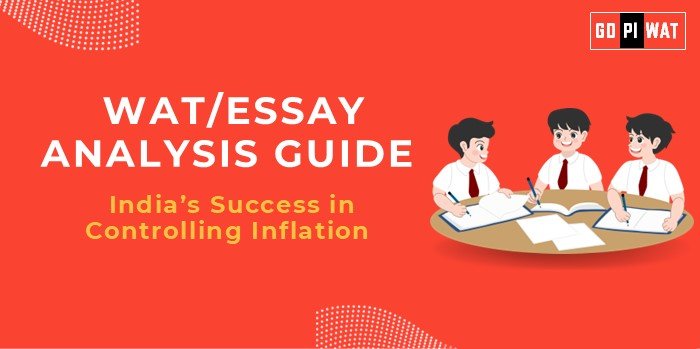📋 Written Ability Test (WAT)/Essay Analysis Guide
🌐 Topic: India’s Success in Controlling Inflation
📖 Understanding the Topic’s Importance
India’s inflation management reflects the intricate balance of monetary policy and fiscal strategies. For B-school aspirants, this topic provides insights into macroeconomic frameworks and policy design.
⏰ Effective Planning and Writing
- Time Allocation:
- Planning: 5 minutes.
- Writing: 20 minutes.
- Review: 5 minutes.
- Preparation Tips:
- Gather updated statistics and comparative benchmarks.
- Structure arguments around policy impacts and future outlooks.
📝 Structuring the Essay
Introduction:
- Contrast Approach: “India’s inflation rate of 6.21% in October 2024 signals new challenges despite prior stabilization efforts.”
- Timeline Approach: “From a low of 5.49% in September 2024 to 6.21% in October, India’s inflation underscores policy pressure in volatile times.”
Body Paragraphs:
- Achievements: Steady monetary policies, global inflation rate comparison.
- Challenges: Rising food inflation, agricultural productivity gaps.
- Future Outlook: Recommendations for supply chain strengthening and agricultural reforms.
Conclusion:
- Balanced: “India’s inflation management reflects notable success but demands renewed focus on food price stability and systemic reforms.”
- Future-Focused: “Addressing agricultural inefficiencies and supply chain constraints will be key to sustaining inflation control in India.”
📊 Analyzing Successes and Shortcomings
Successes:
- Effective Monetary Policy: The Reserve Bank of India’s consistent repo rate of 6.50% helped stabilize inflation without stalling growth.
- Energy Price Management: Subsidies and import diversification reduced the impact of global energy price volatility on domestic inflation.
- Global Positioning: India’s inflation rate of 6.21% remains below the global average of 6.3%, reflecting resilience amidst global disruptions.
Shortcomings:
- Rising Food Inflation: Food prices surged by 10.87% year-on-year in October 2024, driven by insufficient agricultural productivity gains.
- Structural Vulnerabilities: Persistent gaps in rural supply chains and climate-dependent agriculture exacerbate inflationary pressures.
- Consumer Price Volatility: Price instability in essential commodities continues to affect low-income households disproportionately.
🌱 Recommendations for Sustainable Progress
- Enhance Agricultural Resilience:
- Invest in climate-resilient farming techniques and crop diversification.
- Promote the adoption of technology to boost agricultural productivity.
- Strengthen Supply Chains:
- Develop robust storage and transportation infrastructure to minimize wastage.
- Encourage public-private partnerships for rural market connectivity.
- Diversify Energy Resources:
- Expand renewable energy adoption to reduce dependency on volatile fossil fuel imports.
- Implement long-term energy pricing mechanisms to stabilize costs.
- Expand Financial Inclusion:
- Strengthen access to credit and insurance for farmers to mitigate the risks of crop failures and price shocks.
- Enhance digital platforms for direct benefit transfers to reduce leakages and ensure price support.
- Adopt Data-Driven Policymaking:
- Use predictive analytics to monitor inflation trends and preempt supply shocks.
- Regularly update and refine inflation metrics to capture real-time price fluctuations effectively.
✍️ Sample Essays
Balanced Perspective:
“India’s inflation control demonstrates policy resilience but highlights systemic challenges like food price volatility. Structural reforms remain essential for sustainability.”
Solution-Oriented:
“Integrating supply chain efficiencies with climate-smart agriculture will mitigate inflationary pressures and ensure long-term stability.”
Global Comparison:
“India’s inflation strategy, while commendable, requires deeper agricultural reforms to match global standards of price stabilization.”


